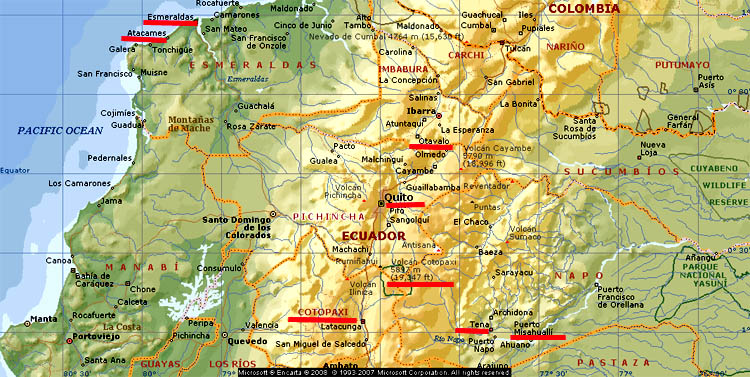If you want to skip directly to the next part, then just hit
Part II
Introduction
This is an abridged description of a trip to and through a part of Ecuador (see map below) during October 1998. The intention is to give a firsthand personal experience of how I did get to and through the country in 18 days. Not many days for a sight-seeing tour, not to mention any adventure. And it was even less than that for that because I had to learn Spanish during 9 days of those 18 days.
Anyway, better than not going at all on this trip, because it was an additional education vacation every employee was entitled to if he can prove that he is attending a course for his personal enlightenment, according to the law of some states in Germany at that time.
The employer, however, was more strict by only allowing a course to improve skills useful to the company. I could convince them that speaking a little Spanish will have a positive effect on the relationship with my Spanish colleagues during my business trips to Spain.
At the time of writing all this, more than 12 years have passed, thus I cannot recall the overall cost, not to mention the prices of hotels, restaurants, bus fares, etc. What I know is that I could reduce my taxable income by all expenses incurred, including the fare for the return flight.
Getting from Germany to Quito
The cheapest flight I could get was with Continental Airlines from Frankfurt via Houston to Quito, the capital of Ecuador. I arrived in the late afternoon of a Saturday. My Spanish teacher and her husband picked me up and I was brought to my family home stay which was located not far from the airport in a very good neighborhood.
Amazonia
Since I was here not only to learn Spanish but to also see and experience as much as possible of this country I boarded a bus at the Terminal Terrestre de Cumanda early Sunday morning. My final destination was Misahualli, according to my guidebook the easiest and quickest place to begin a trip into Amazonia.
It is not the Amazon river yet, but a tributary with the name of Rio Napo, which will become the Amazon river after it meets Peru's Rio Maranon.
Ok, let's go. The bus took around 6 hours to get to Tena. After another 20km with another bus I finally arrived in Misahualli.
Click the small picture to get it enlarged
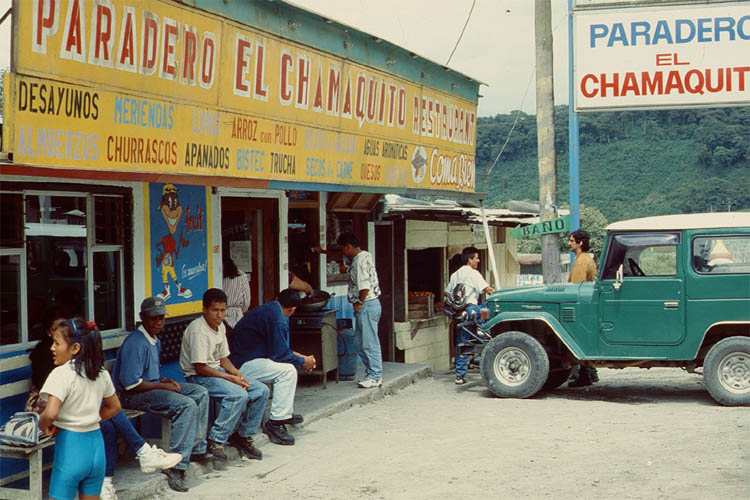
| Breakfast break at a bus stop
|
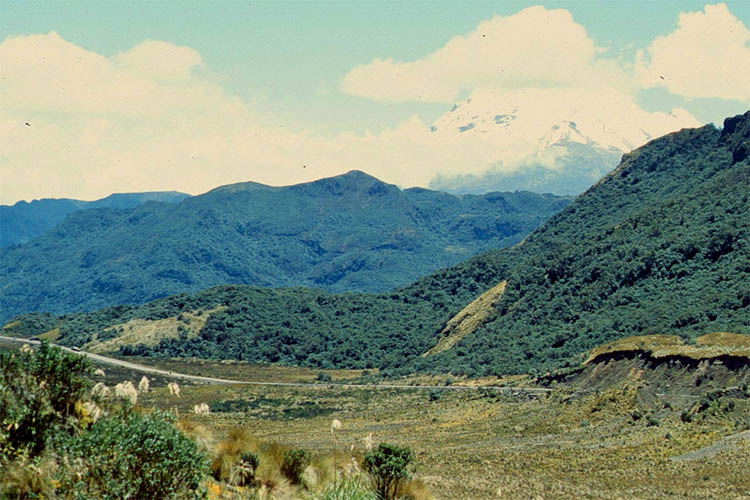
| Continuing through the countryside
|

| Arriving by bus
|
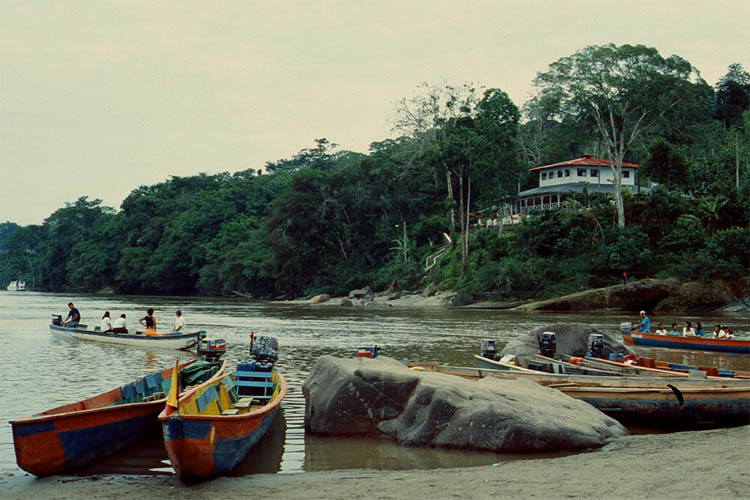
| in Misahualli
|
What next. I didn't have much time. I could not have made it back to Quito the same day. But fortunately the following Monday was a national holiday, so no Spanish course yet. But still. Should I take a public boat plying the Rio Napo not knowing when a boat is coming back?
The best would be joining some other tourists and charter a boat. But there were no other tourists around. So I negotiated the cheapest possible boat trip for around 100 USD leaving right away for the half day with a guide, a boatman and myself.
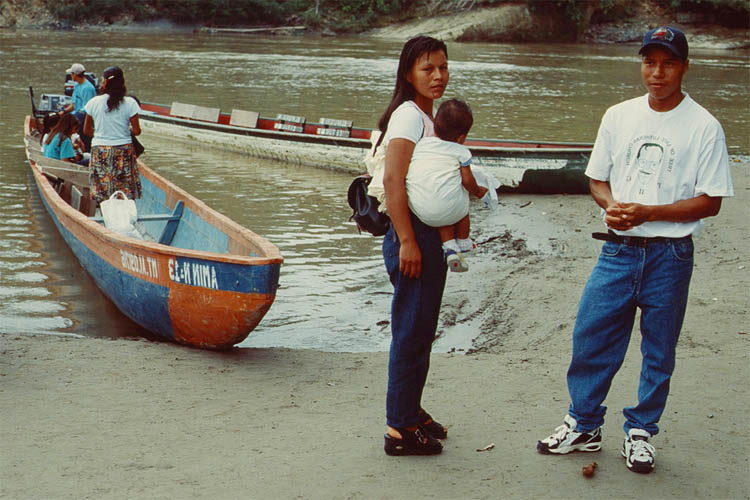
| Where is the public boat?
|
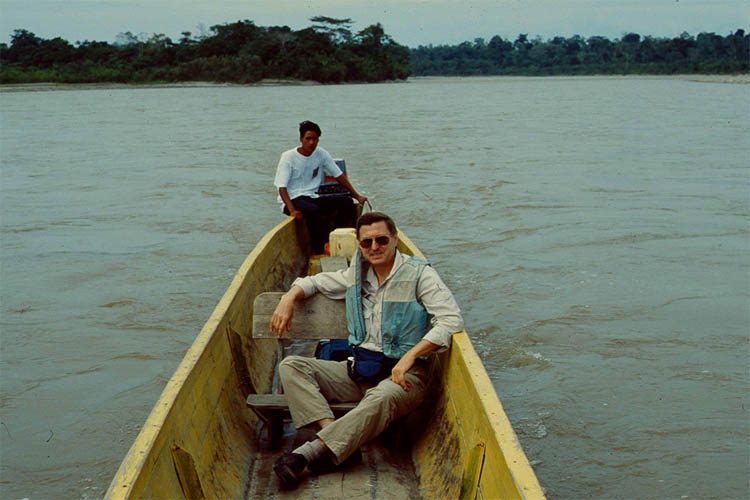
| I rather take my own boat
|
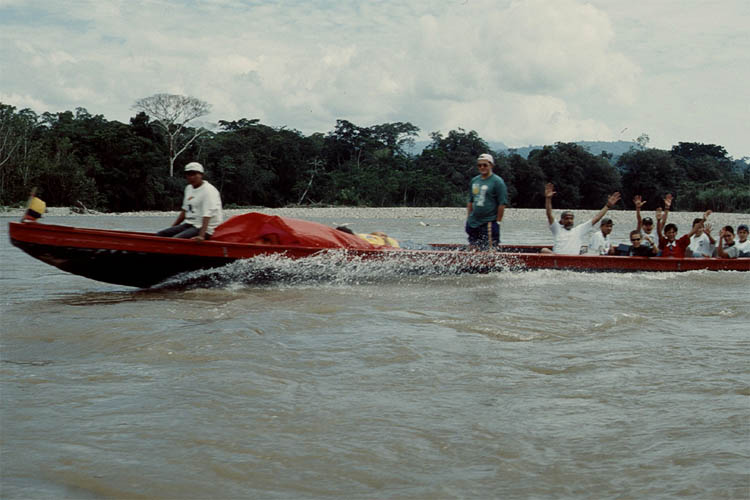
| A public speed boat is taking us over
|

| But we are taking this small boat over
|
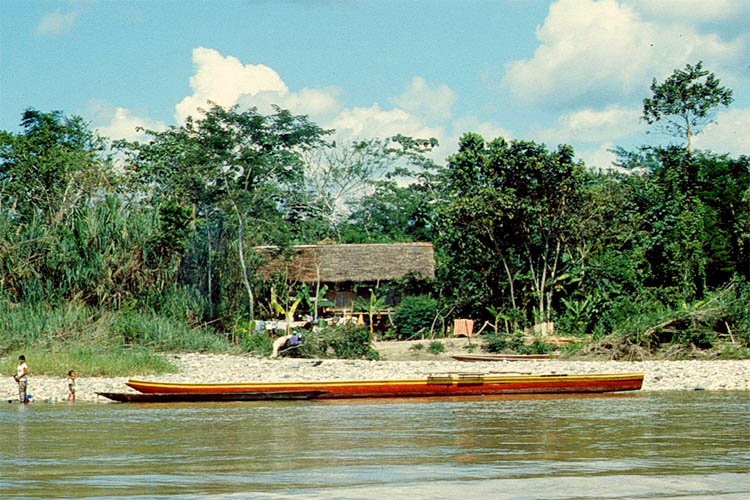
| Passing by small settlement
|
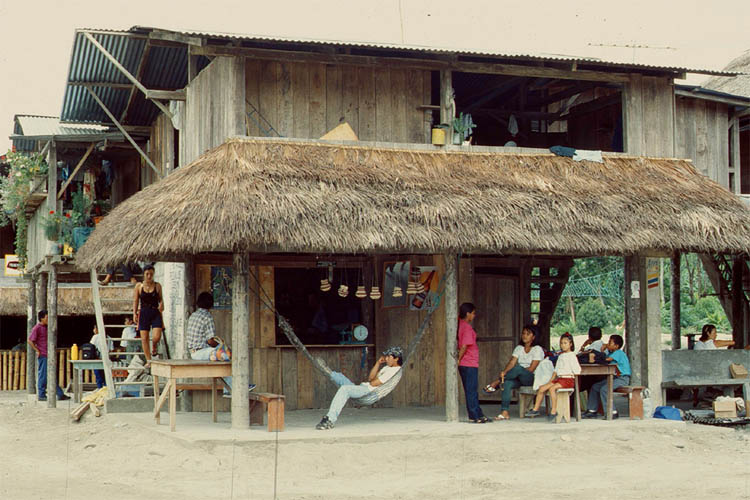
| Visiting a laid back village
|
Ok, this is not real deep Amazon jungle with Indian tribes living in the stone age. The population is a mix of "colonists" and of some transplanted or "acculturated" (that expression is more correct than civilized) Indians. The not so "acculturated" Indians retreated farther into the jungle and want rather to be left alone.
I will not describe how to get to them, because I will not help to destroy their way of life. The reason is that tourism, especially package tour tourism, has done more bad than good to them. It happened that hordes of tourists entered their huts while the locals were working in the fields. What a rude behavior. Imagine if those Indians come into your house uninvited and sneak around in every corner. And most of the Dollars each tourist pays per day goes into the pockets of the few "colonist" travel agencies.

| Climbing up a hill in the jungle
|
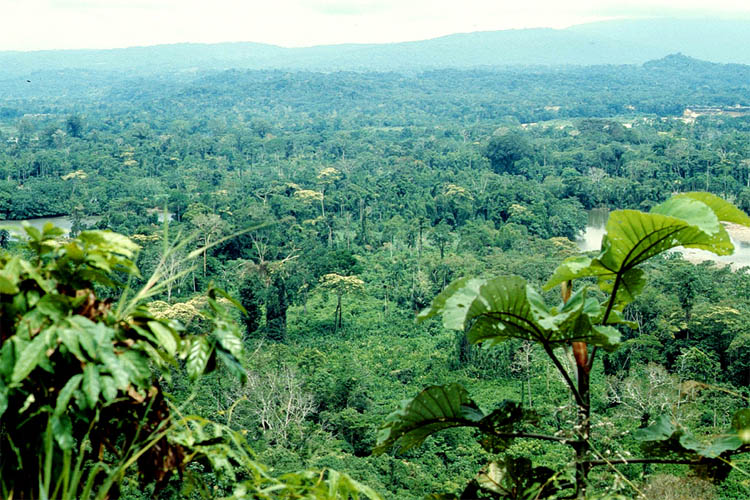
| Looking down to the Napo Valley
|
For the time being I am here for the beautiful countryside and interesting nature. My guide explained a lot in Spanish, which I hardly understood. Maybe I should have visited this place after my Spanish course.
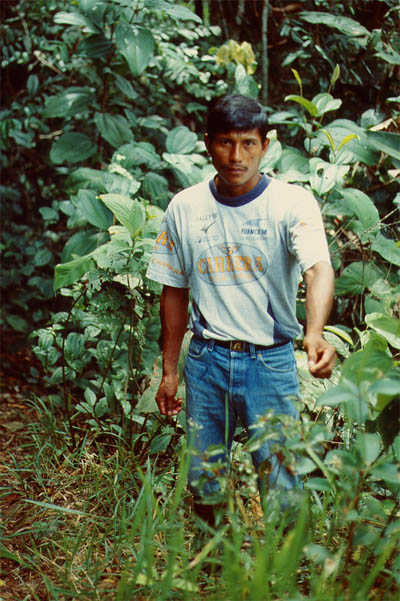
| My guide explains a lot
|
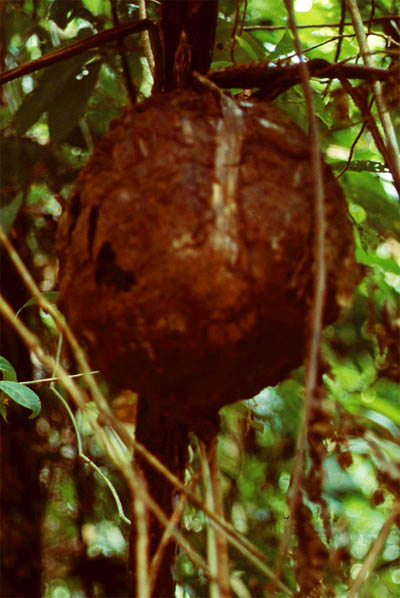
| But what this was I forgot
|
Mostly, the flora is still undisturbed. Some fauna is better not to disturb. Like the killer bee hive up in the tree or the crocodile in the Rio Napo as you can see.
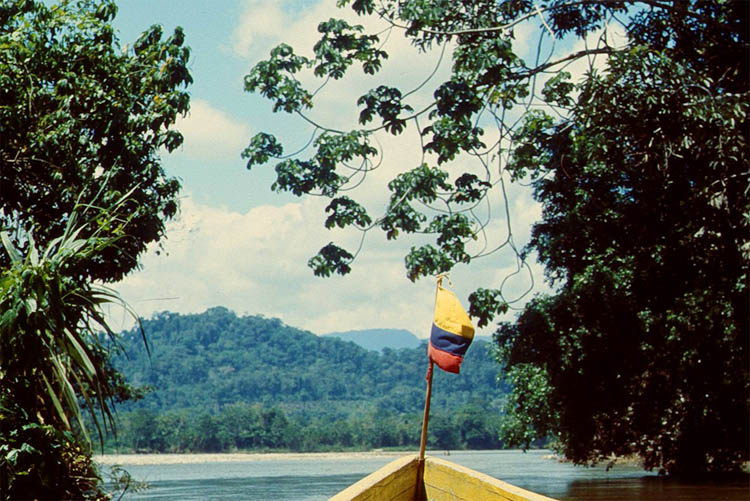
| Deeper into the jungle, what a shock
|

| In front of us appears an Amazon Croc
|
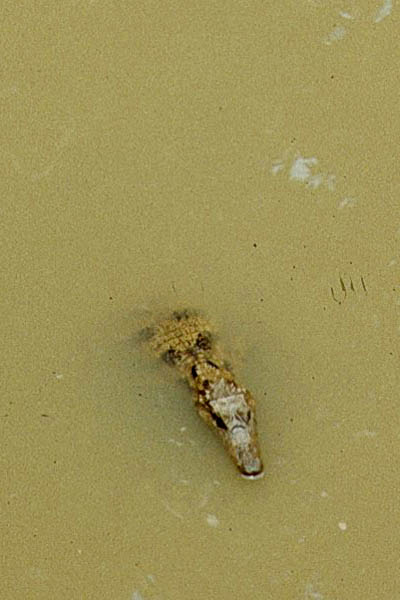
| Now getting a close up look
|

| The baby in my hands I took
|
But very few animals are to be found in the wilds around here anymore. Most of them have already been killed by poachers or caught for sale by illegal traffickers. Some animals could have been confiscated and brought to a rehabilitation center before they are released back to the wilds. Also injured animals brought in by locals are cared for. One of these centers I was going to visit now, the AmaZOOnico. Take a look .
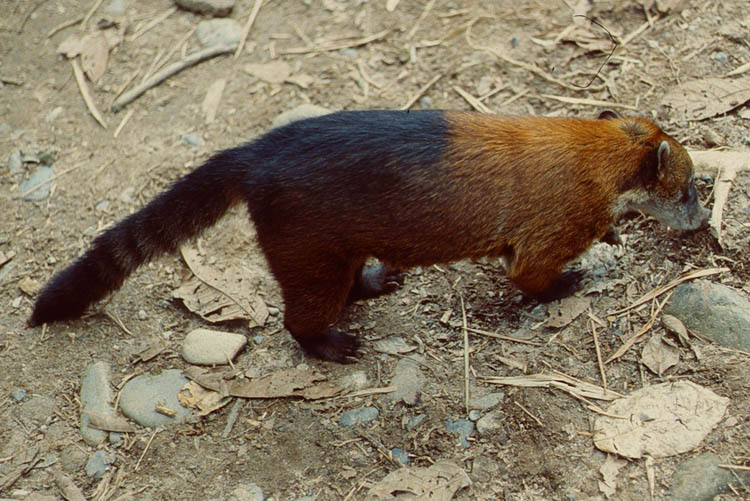
| This little racoon I would touch
|
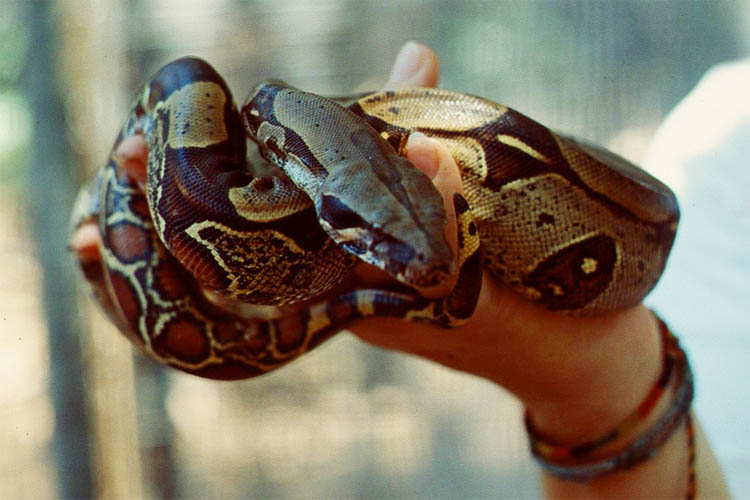
| but the little boa constrictor not that much
|
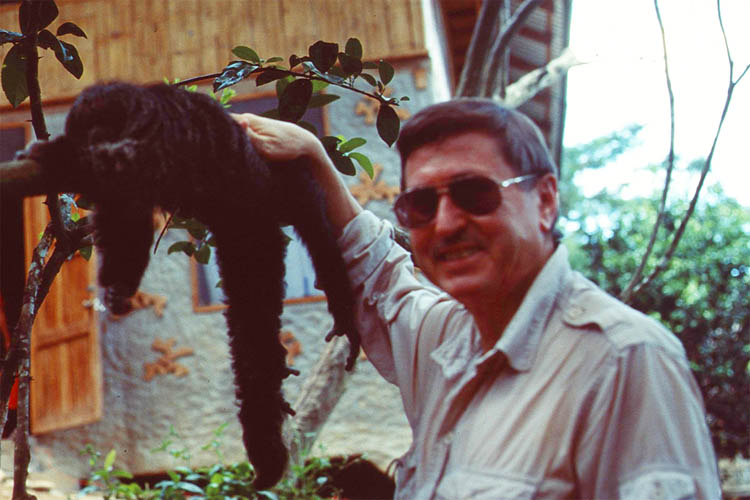
| And patting the sloth is just right
|
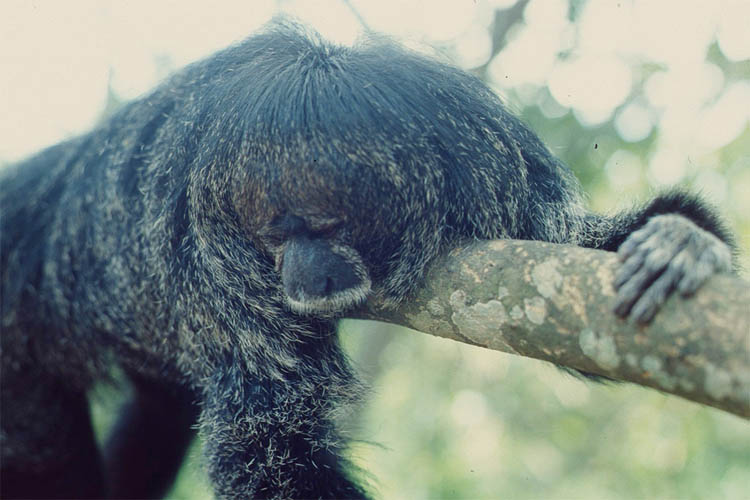
| because he is too lazy to bite
|
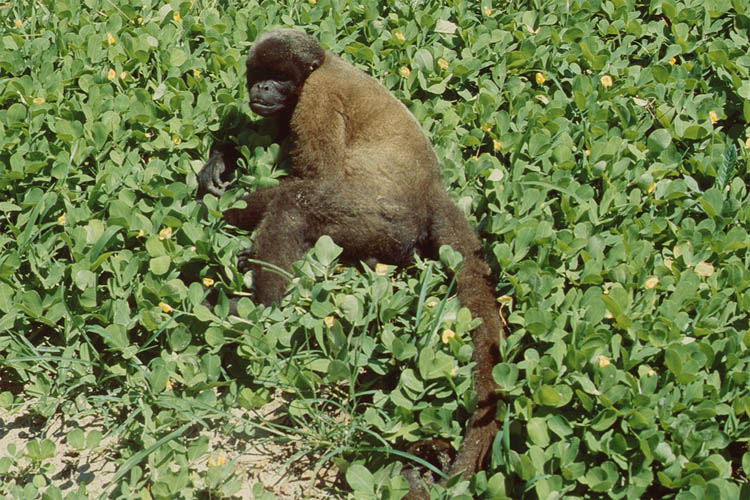
| This monkey may bite you to the bone
|
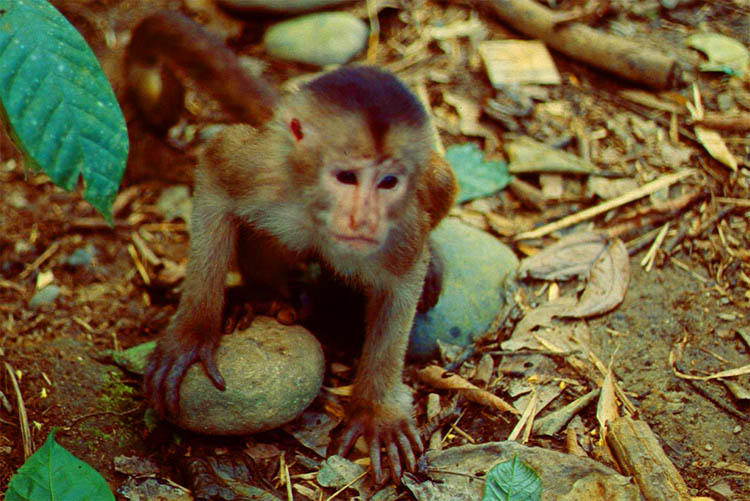
| This little one may even throw a stone
|
Actually nothing did scare me. I wonder whether the parrots are here on free will. Maybe after being rescued they found a home here.

| Oh, what a beautiful sight: a wild parrot sitting in a tree
|

| How come that this one is sitting on a wall, as you can see
|
I really would have liked to stay much much longer. There are all kinds of accommodations from cheap basic pensions to expensive jungle lodges. Not that many were close to Misuhualli but more so farther down the Rio Napo on the way to Coca and after. There are also so many things to see and to do, especially during a jungle tour, which may take several days. Look up the guidebooks or in the Internet to learn more. I will just take a rest before we have to return to Misahualli.

| After this "adventure" I needed some rest
|
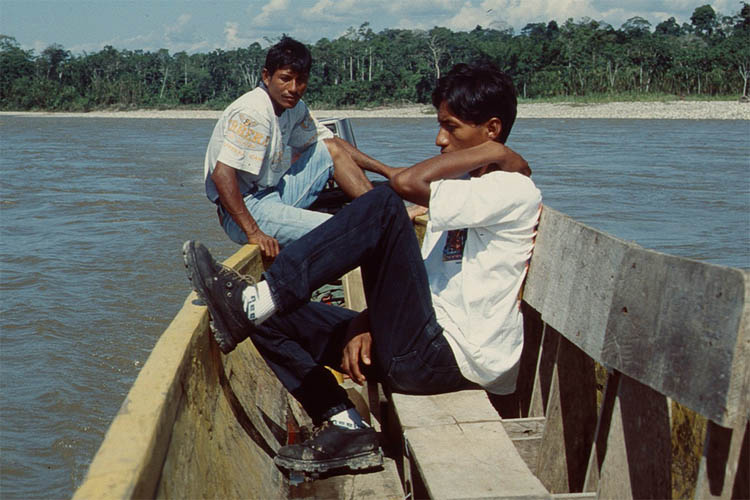
| After that I had to head back
|
From Misahualli via Tena to Quito
Back in Misahualli I caught the bus going to Tena where I stayed overnight before heading back to Quito. It's a small town but it is the capital of the Napo Province, the largest in Ecuador. It was also the most easterly colonial settlement in the old times.
But Old East was like Wild West: the most dangerous place in the sixteenth century, when many Indian attacks tried to chase the Spaniards out of their hunting grounds.
But now it's a peaceful banana town (even if banana is not the main export earner anymore but oil).
But Quito, the capitol of Ecuador, is a little bit dangerous now. Especially its landmark El Panecillo. Not so much on the top but walking up that hill you are likely to get robbed. No protection by the Virgin of Quito, of which the statue is the main reason to come up here beside the view down to town .

| Many chiquitas & bananas in the town of Tena
|
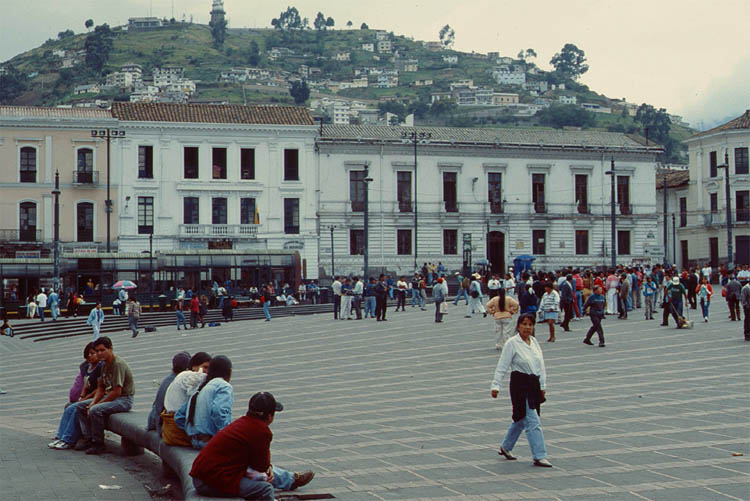
| Back to Quito just in time. In the back you see El Panecillo
|
Now I can tell you about the family I stayed with during my language course. This family was very well chosen by the Eurocentres Organization as part of the whole package: own room, breakfast and dinner together with family members, practical Spanish conversation included.
And here it was safe. Very safe. The house was surrounded by a high wall. The iron gate was double locked. A watch dog was living between house and wall day and night (once the landlady was very angry with me after I let the dog come inside, because a burglar may just try to climb the wall).
Ok, that was only the house. In the street around the block was a gate with a guard with a gun. And then farther down at the end of the compound another one. And this was just a middle income neighborhood. What about the millionaire's quarter?
Ok, my school was not that much secured. It was also in a "good" neighborhood, but up the hill on the other side of the Quito valley and I did get a little out of breath walking up because of the altitude of 2850 meters.
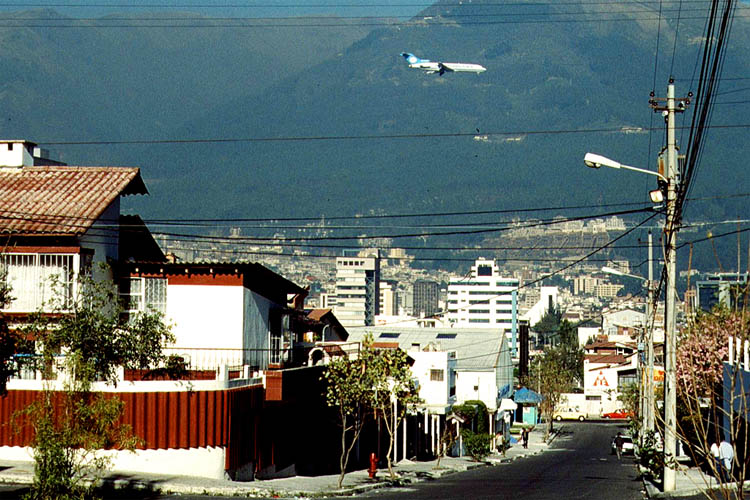
| The street where I lived with "my" Ecuadorian family
|
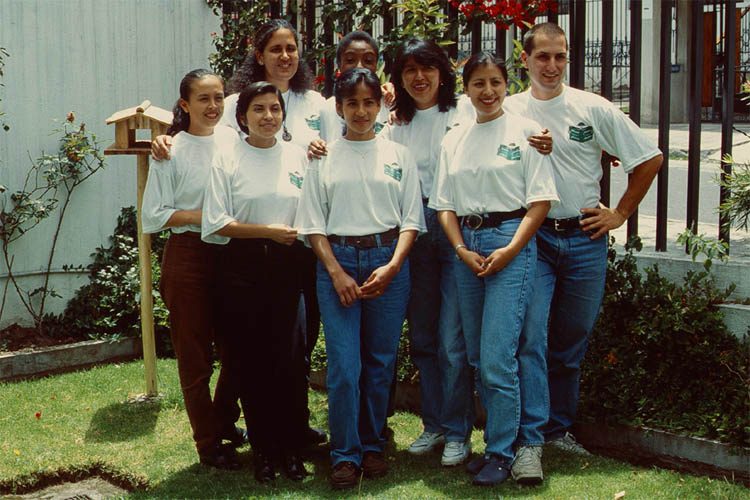
| All the Spanish teachers with their leader from Germany
|
The language school was led by a German guy with his Ecuadorian wife, who taught Spanish together with a bunch of other Spanish teachers. One of them was my private teacher. I was supposed to join a full day crash course class with up to four other students, but there were none with my beginner's level. So, I accepted the offer to have private lessons alone, but then not full day but half a day.
That was wonderful. Now I had a crash-crash course and free time the whole afternoon for sight-seeing and intermingling with the locals. And in the evening there was mostly partying either in the school or in some places in midtown. One of my favorite joint was the salsateca Seseribó, where we danced to the music of a life band and listened to the ecstatic songs of an old señora from Cuba.
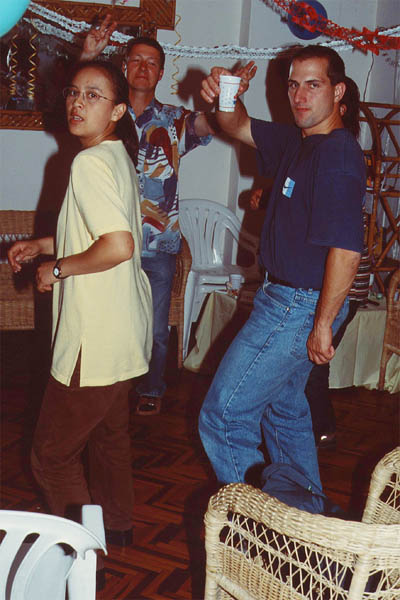
| They knew to celebrate
|
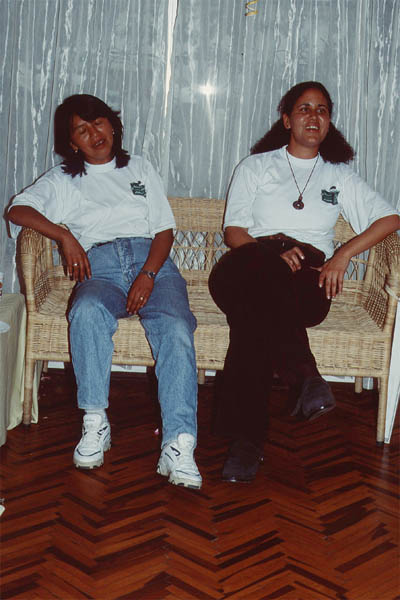
| until exhaustion
|
Most afternoons I was roaming around in the city. First I walked all the way from my protected neighborhood to and through the new part of the city in the middle of the Quito valley (just 4km wide and 17km long). You find department stores, office building, shopping centers and of course fast food chains.
In front of one shopping center I encountered two guys, very much looking like officials, who tried to evict an indigenous looking family who were just trying to settle down on the sidewalk. My Spanish was not good enough to ask them why.
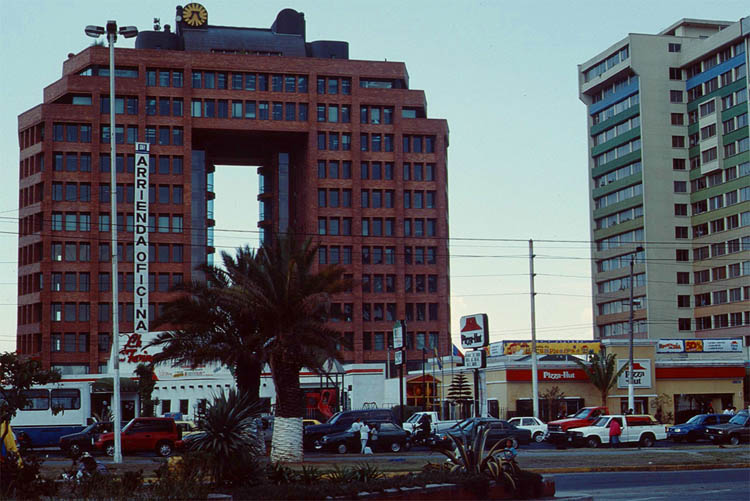
| New town with office buildings
|
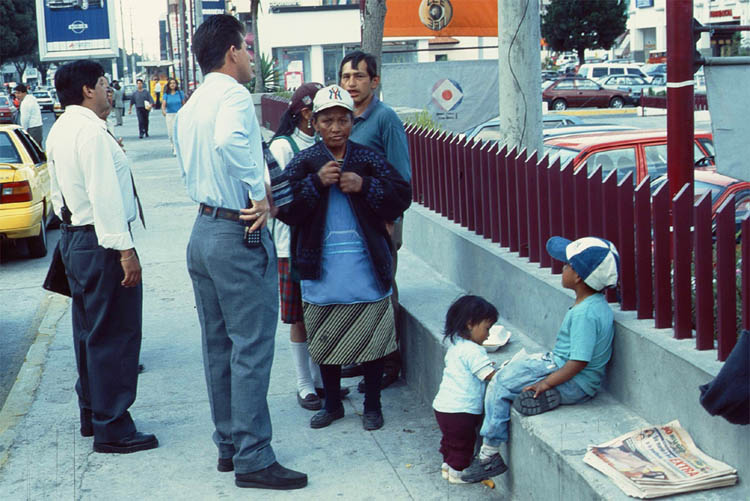
| Off limit for indigenous people?
|
Then I continued down south until I did get to the Mariscal Sucre district with the Avenida Amazonas in the middle. It's the most modern street for walking along boutiques, sidewalk cafés and souvenir stalls. The side streets boast with many good restaurants, bars, salsathecas and discothecas. Here is where the action is, especially in the evening
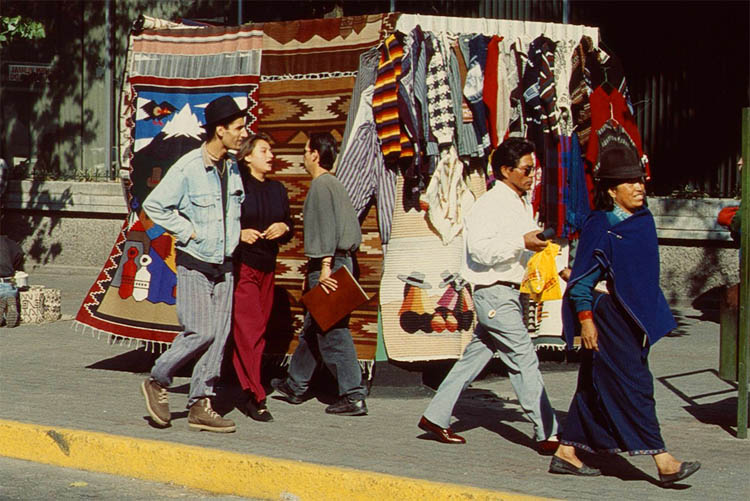
| Souvenir stall in the new town
|
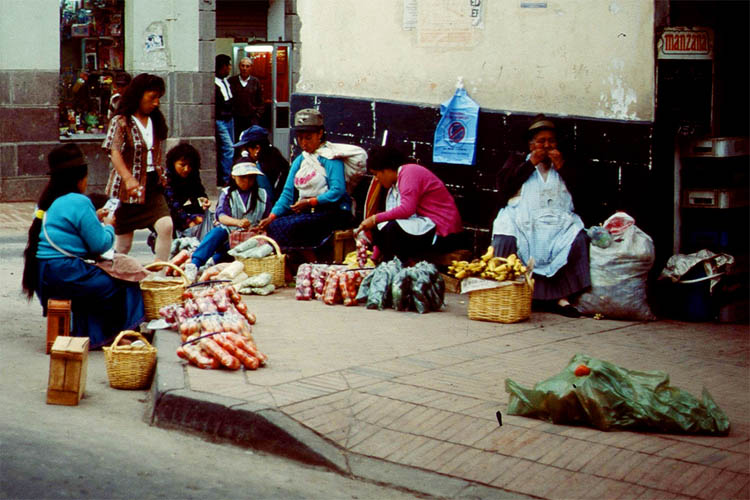
| Street vendors in the old town
|
Then slowly I did get close to the old town by walking further south. Here I did get lost between so many churches and museums. And here you better watch your pockets while looking around, because this is a hunting ground for pick pockets. Even the rucksack should not be carried on the back but in front, because it may be slit open unnoticed.
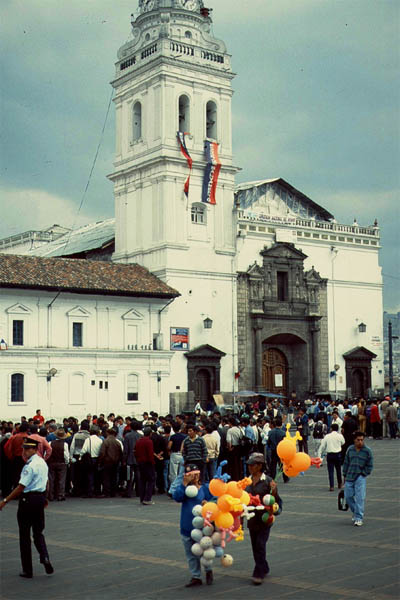
| The Santo Domingo church
|
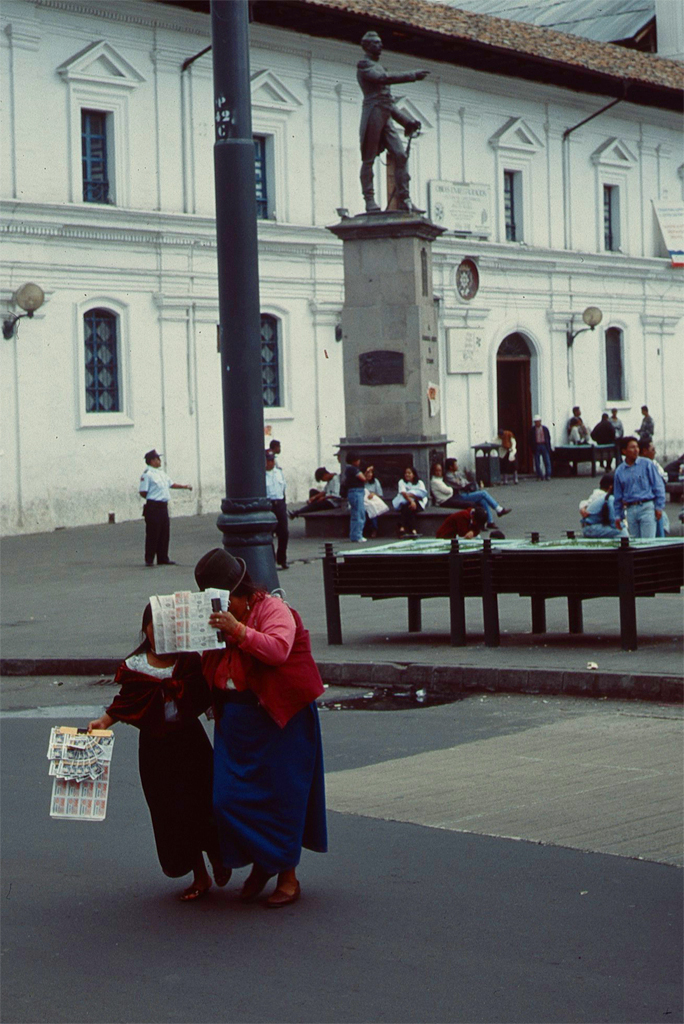
| with the Marshal Sucre statue
|
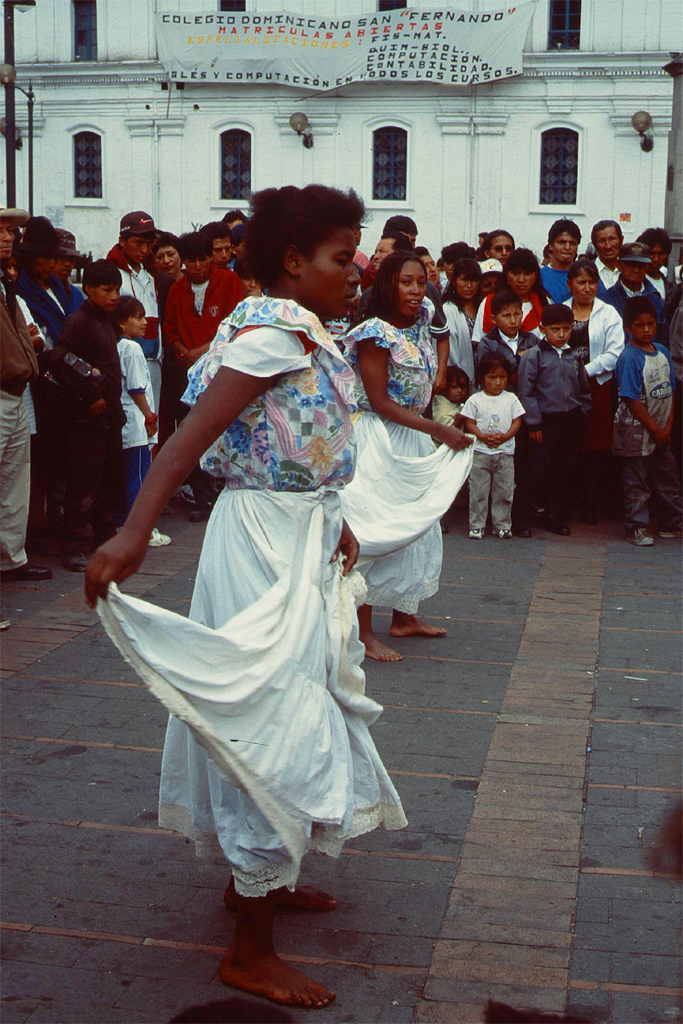
| The busy Santo Domingo plaza
|
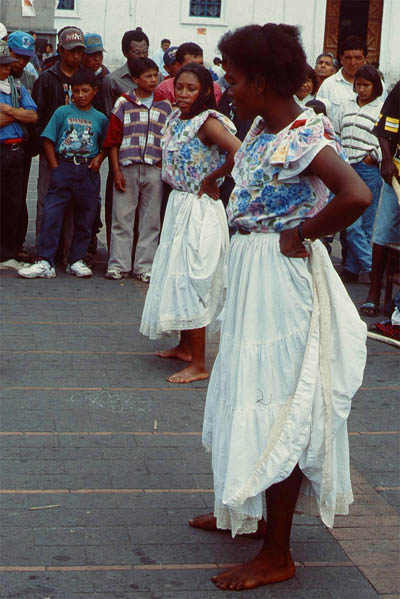
| with a folklore dance performance
|
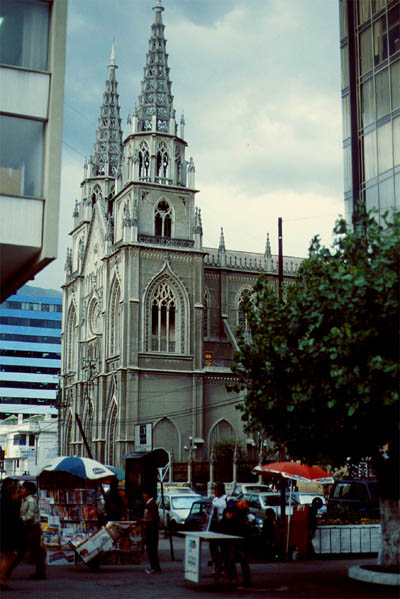
| Another church
|
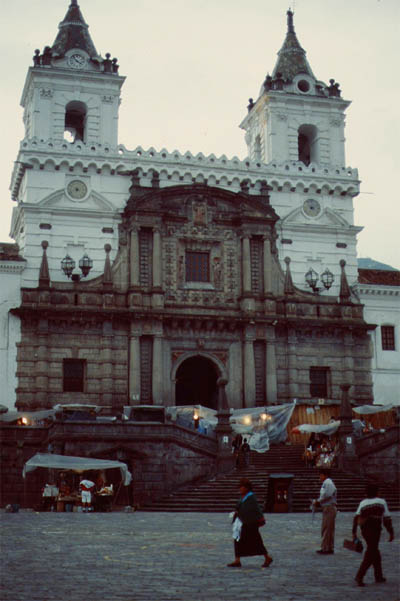
| One more church
|
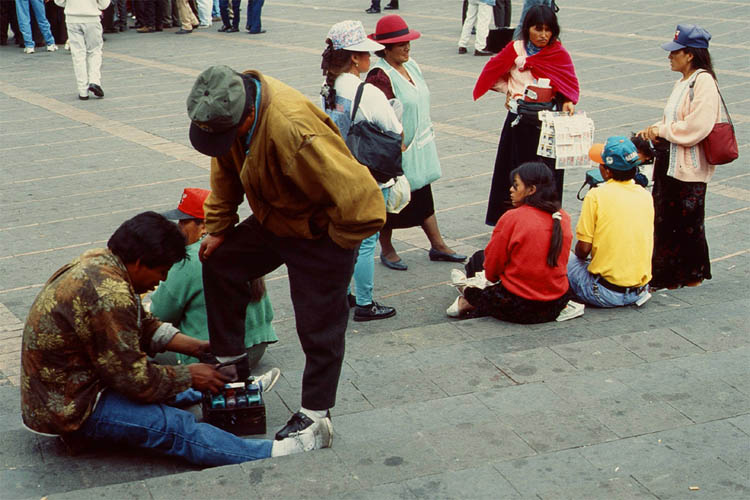
| I don't need a shine for my shoes
|
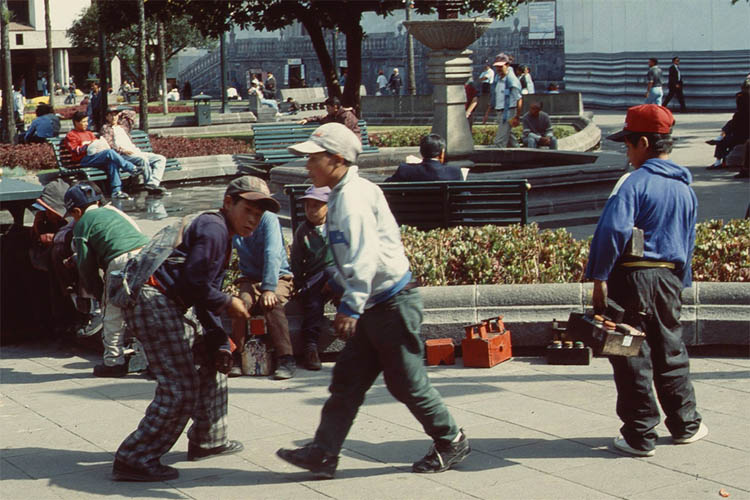
| The only job for many boys
|
Ecuador was part of the Inca empire ruled by Atahualpa until captured in 1532 and executed in the following year. After some fights with Atahualpa's general Rumiñahui the Spaniards finally took over control in 1535 until they lost the final battle against Bolivar's Field Marshal Sucre in 1822. Liberated Ecuador was first part of Gran Columbia but became fully independent in 1830.
But unfortunately the relatively peaceful centuries of Spanish rule became a typically new Latin America warfare between rival parties. Several presidents have been assassinated. The country was ruled more by the military than civilians. The most recent period of democracy began in 1979 but still with a lot of turmoil since then.
At the time I was there, though, it was relatively peaceful. The new president Jamil Mahuad was just elected, so the military just waited for the next opportunity to overthrow him, which happened just two years later. The reason: the president introduced an austerity program to reduce massive foreign debts, etc., that also meant cutting benefits for public service, including the police and the military. So they did not like it to get pay cuts, of course. So again: it's the economy, stupid.
The last incident was just on September 30, 2010, when President Rafael Correa was taken hostage in a hospital by police officers who were angry about the austerity measures to cut their benefits, again. He could escape and stayed in office.
The president's office is in the Palacio Presidential and very well guarded by soldiers and the police. But what kind of a protection is that, if the military and the police are the ones to usually overthrow the president.
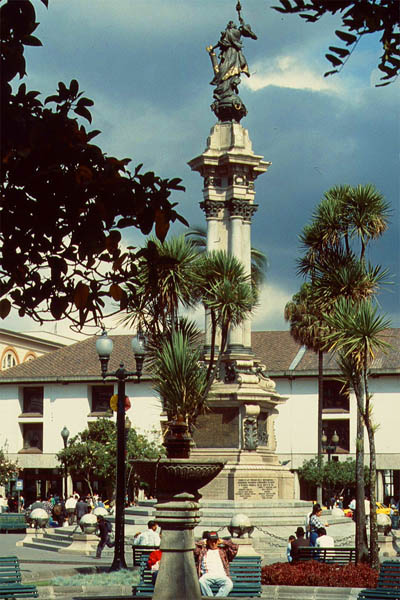
| Plaza de la Independencia
|

| with the Palacio Presidencial
|
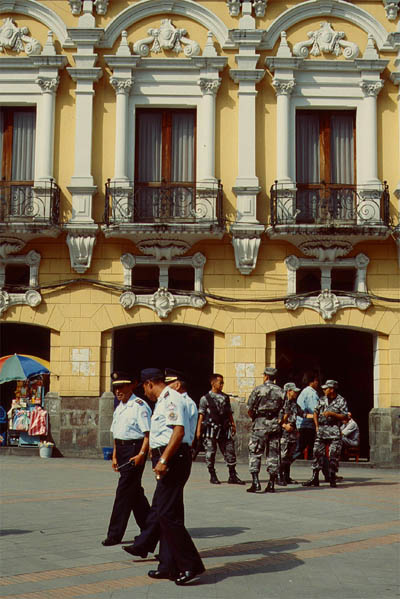
| Surrounded by many soldiers and the police
|
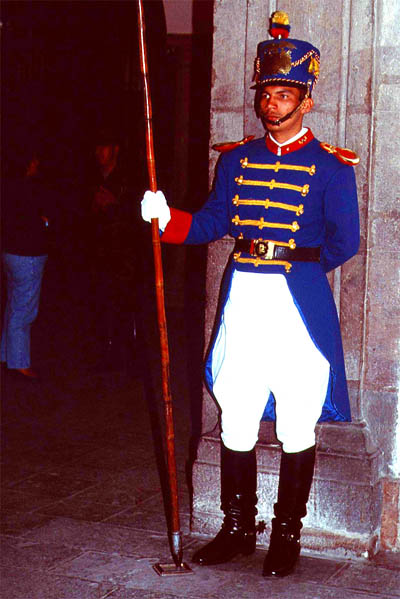
| and also flanked by old fashioned guards
|
As far as the economy of Ecuador in the years 1998 to 2000 is concerned there are some similarities with Greece (and some others) as of the year 2010. Both countries with massive foreign debts introduced an austerity program. People demonstrated against benefit cuts. The difference though: Ecuador devalued their national currency, the sucre, by 65% and changed over to the US Dollar as the new national currency.
Greece, however, cannot devalue (yet), because it uses the common European currency, the Euro, and thus must continue to pay high interest rates for their loans because of their low rating now and thus gets deeper and deeper into recession besides not being able to pay it all back.
I suggest that Greece does the same in order to get out of that down spiral: But first it has to get back to their old national currency, the Drachme, devalues it and subsequently either keeps the Drachme or introduces the US Dollar. How about that? The other European countries do not have to worry about their Euro anymore and Greece will better recover by having a competitive price advantage for their exports (let's wait and see whether our politicians will be able to make the right decisions for the future of Europe).
Back to Ecuador: around 40% of export earnings are coming from food products, primarily bananas, and another 40% comes from oil. The rest is contributed to other products and last not least to tourism.
Otavalo
Yes, tourism is a very important for Ecuador. And it really has much to offer. From the Amazon over the Ring of Fire to the Pacific with Galapagos, and much much more, like Otavalo.
This town is very famous for its Saturday market. So I went there on the Saturday of my first weekend together with some other Germans attending the same language school but different classes.
It was close enough to Quito for a day's trip but it is also a place to stay longer, if you got the time. We didn't. There is much to see in town but more so around. Ok, first the market or markets, because there are three of them not to count the stalls in the streets. And it's not just a regular market for the locals from town and the villages around selling and buying food and animals.
It's also a market for the tourists to look at and buy the wonderful handicrafts, especially the colorful woolen goods, such as ponchos, blankets, scarves, sweaters, bags, etc., as well as embroidered blouses, shirts and shawls, etc., all in Otavalo designs. These products became famous worldwide and thus are exported into many countries and thus made the people of Otavalo the most prosperous group in Ecuador. Come with me now around the market and take a look yourself.
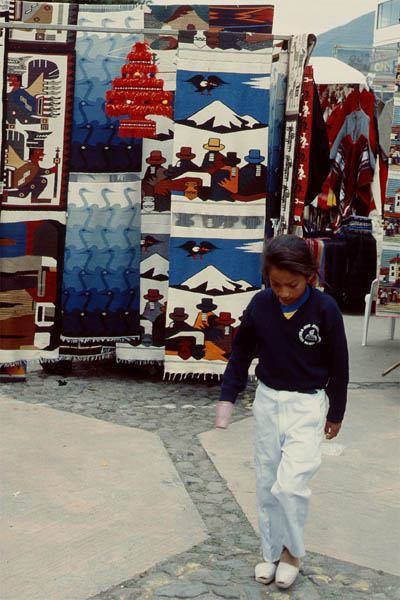
| Specific design
|
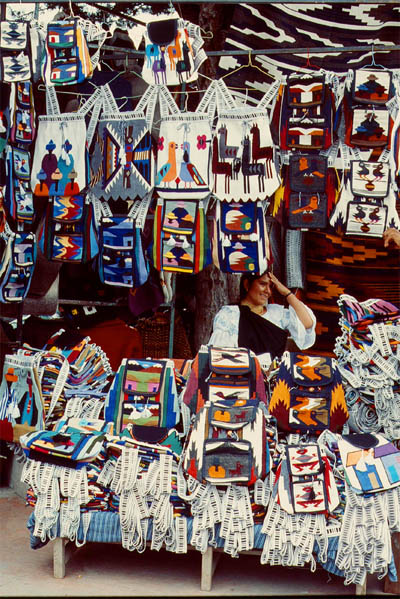
| Famous pattern
|

| Winding wool girls
|
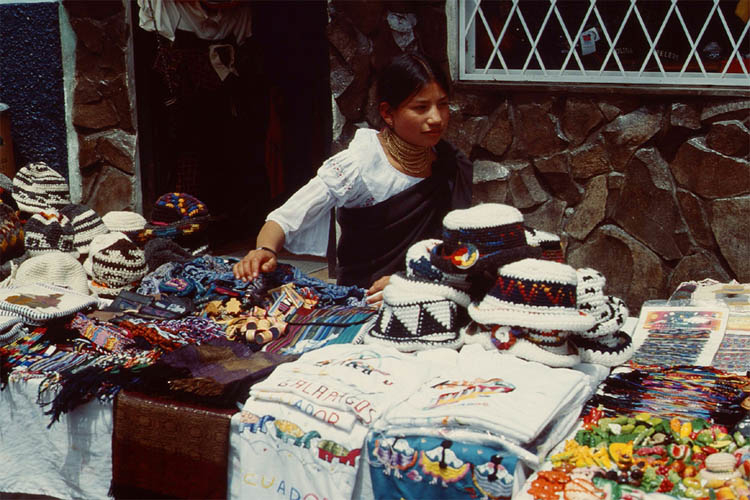
| Selling embroideries
|
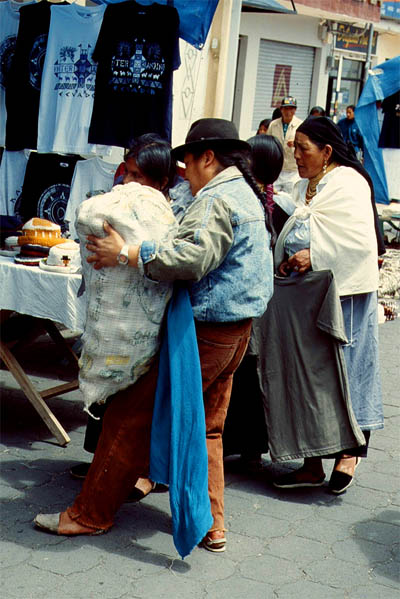
| Selling t-shirts
|
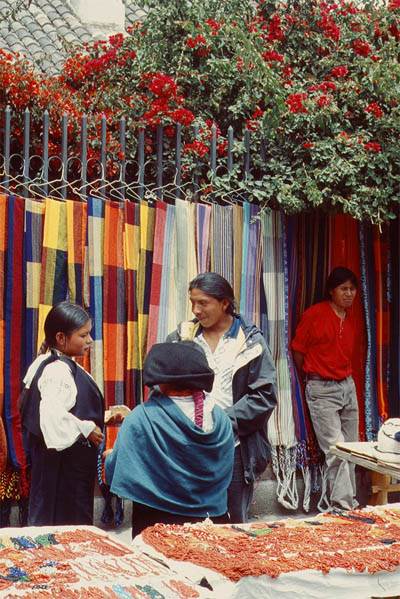
| Selling beads
|
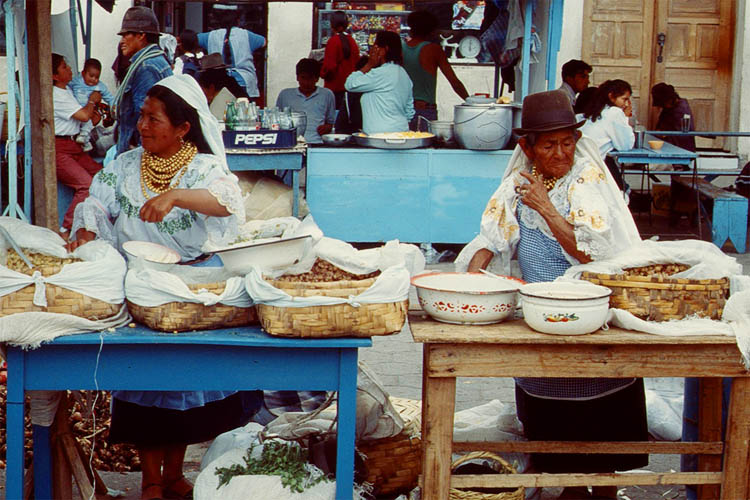
| They are selling something
|
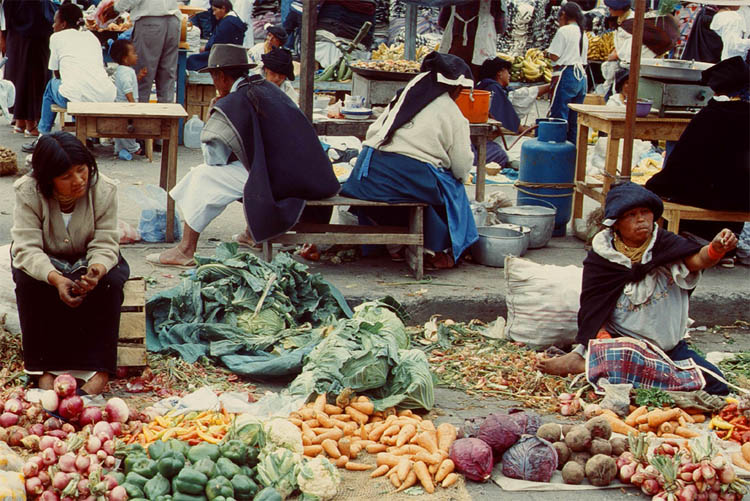
| They are selling veggies
|
People, people all around. But it was not a big crowd. Only around 22,000 inhabitants were living in town according to the 1996 census. Mostly mestizos. Around 40,000 Indians were living around the town in small villages, who come to town on market days. Most locals still wear their traditional attire, not only to go out but also at home.
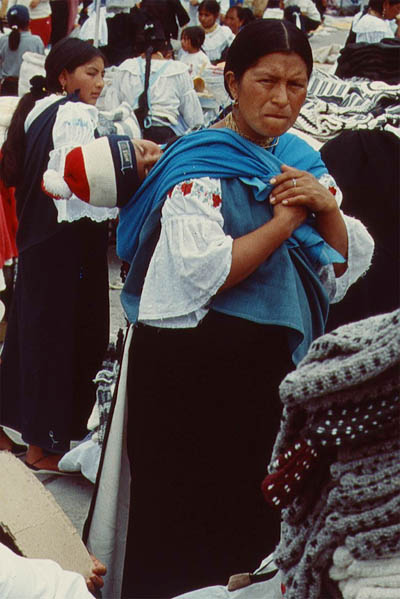
| Strong mothers
|
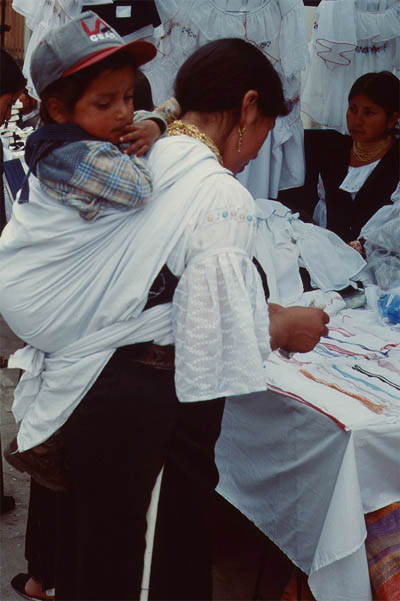
| with big babies
|

| Old lady
|
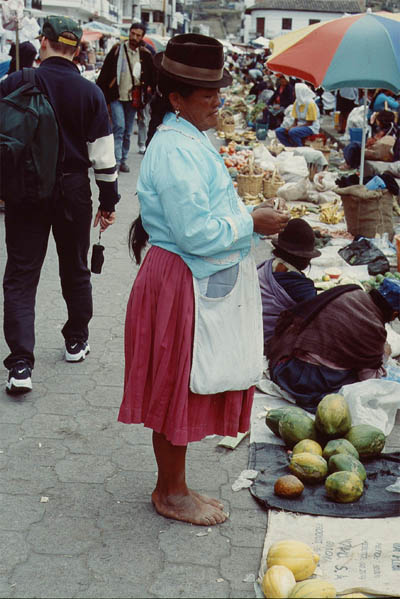
| Big lady
|
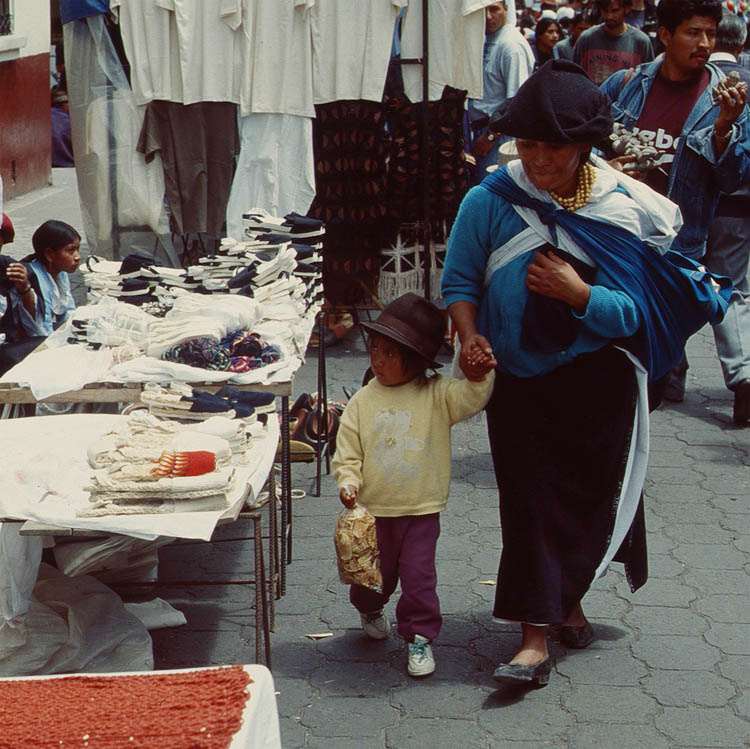
| Mother and daughter
|

| Godfather?
|
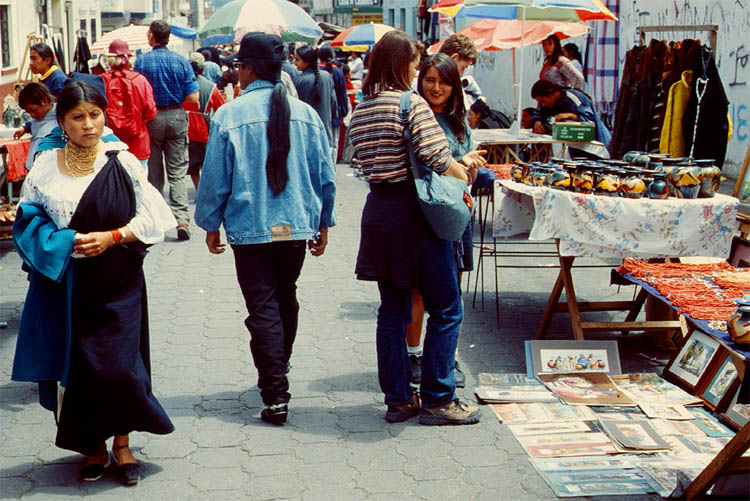
| Young girls
|
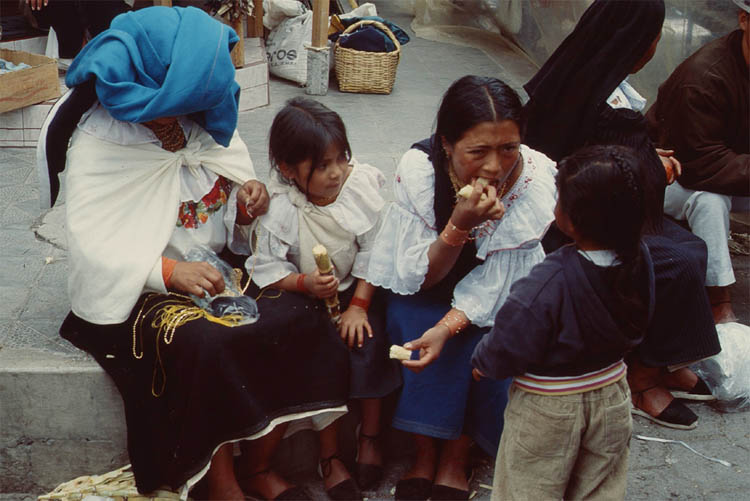
| Three generations
|
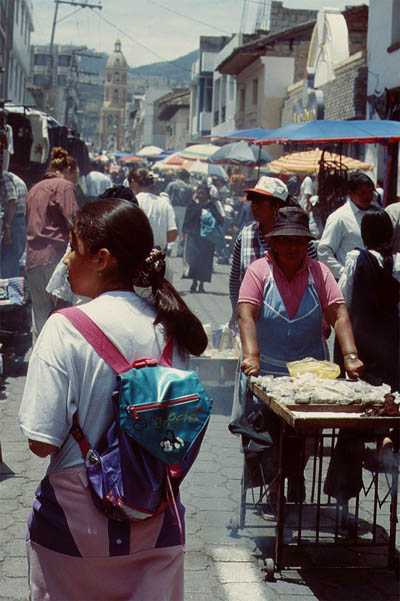
| In the busy streets
|

| of Otavalo
|
After visiting the market we had lunch in one of the many restaurants. What to do in the afternoon? We heard about a beautiful lake or lakes up in the mountain, the Lagunas de Mojanda, located 17km from Otavalo. How to get there? We hired a taxi for the trip back and forth including waiting time at the lakes.
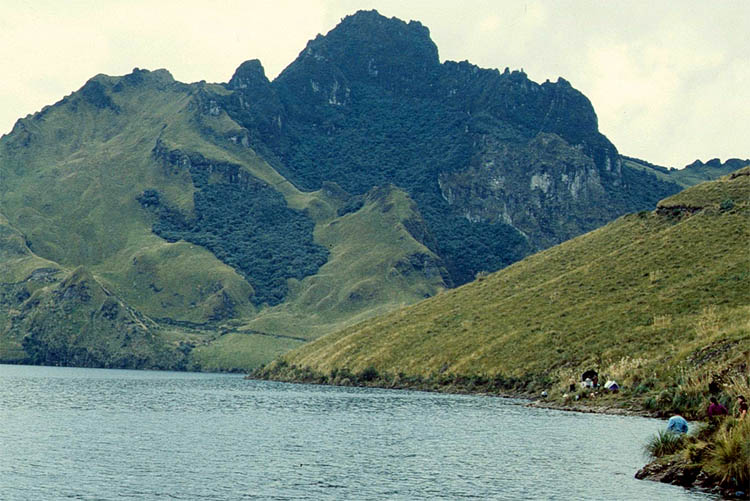
| The lakes
|
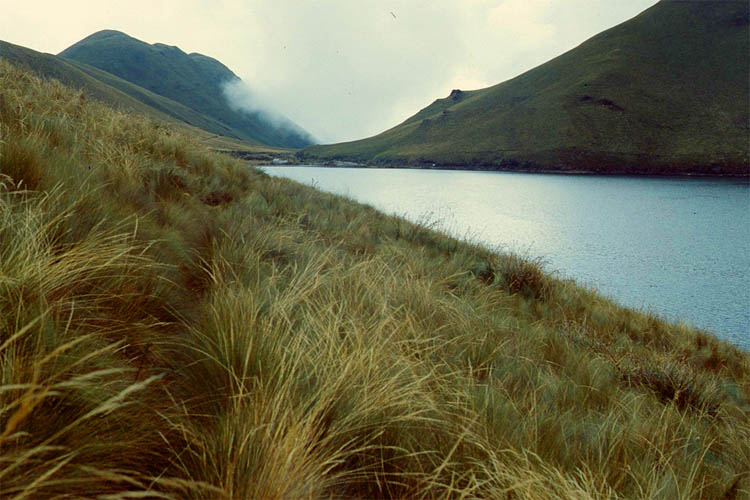
| Lagunas de Mojanda
|
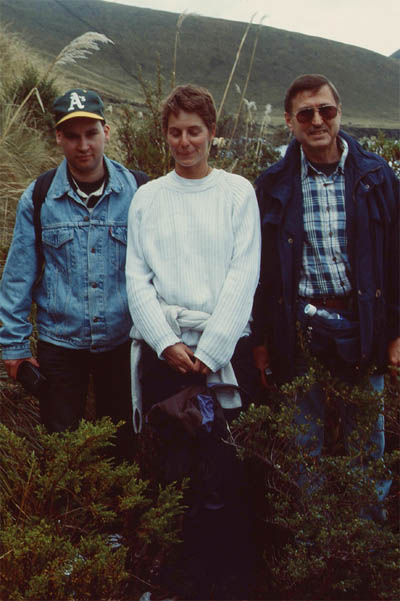
| Walking along with my fellow students
|
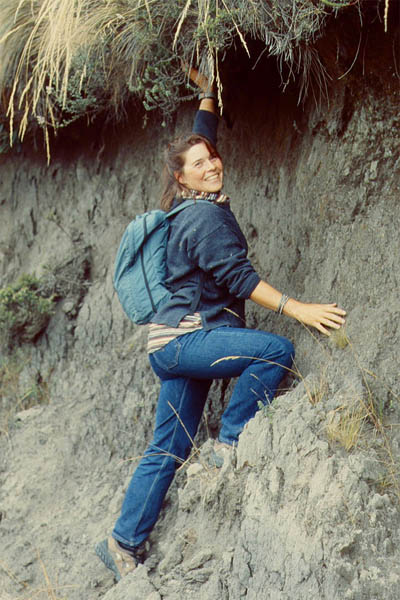
| But didn't make to climb the mountains
|
Same Saturday, another event just happening when I came home. A party was going on with a real Mariachi-Band, translated marriage-band. But there was no wedding, but just a birthday celebration. Originally, it was a band playing on weddings but it became the traditional Mexican Band performing on all occasions.
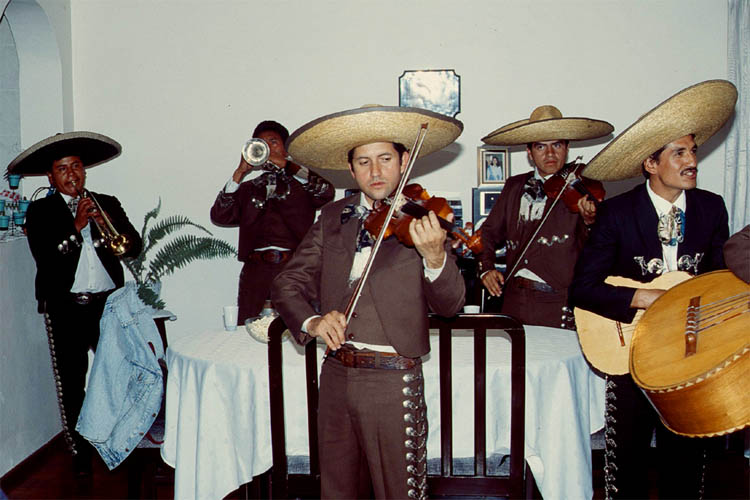
| In the eveining
|
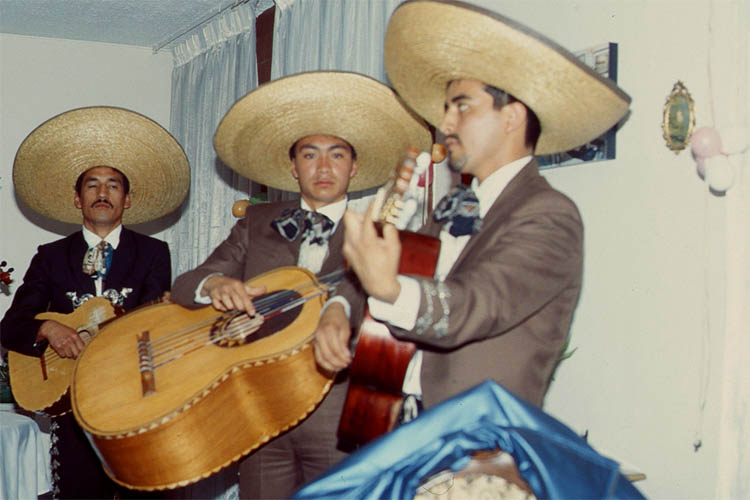
| came the Mariachis
|
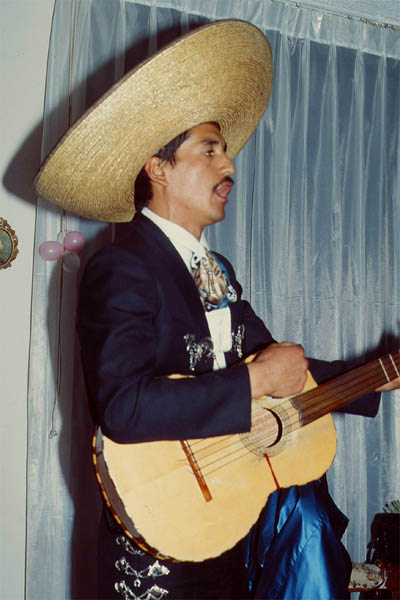
| The caballeros
|
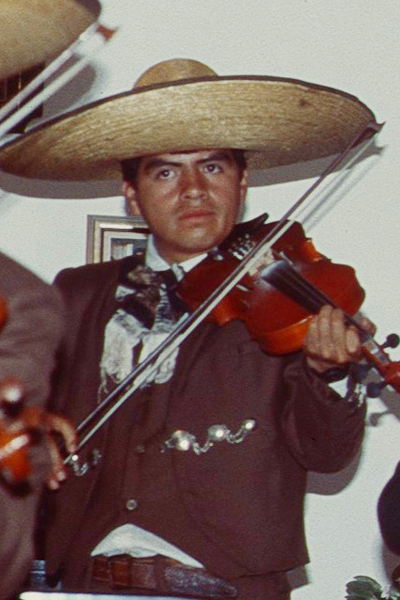
| playing habanera?
|
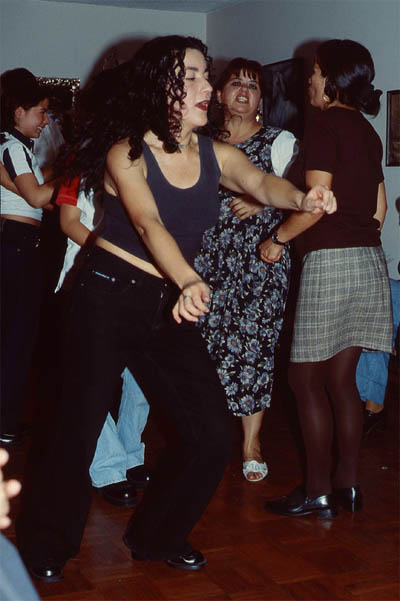
| While watching extasiada señorita
|
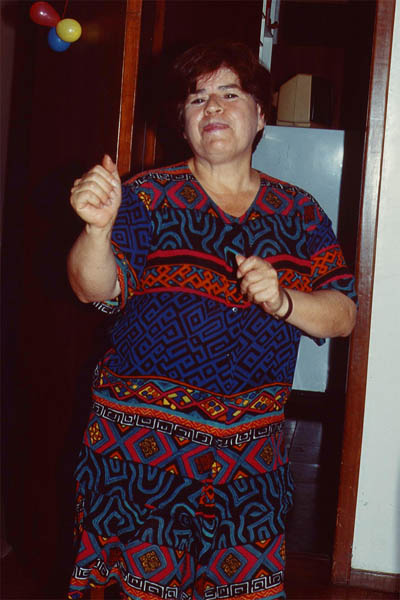
| and my danzarina señora
|
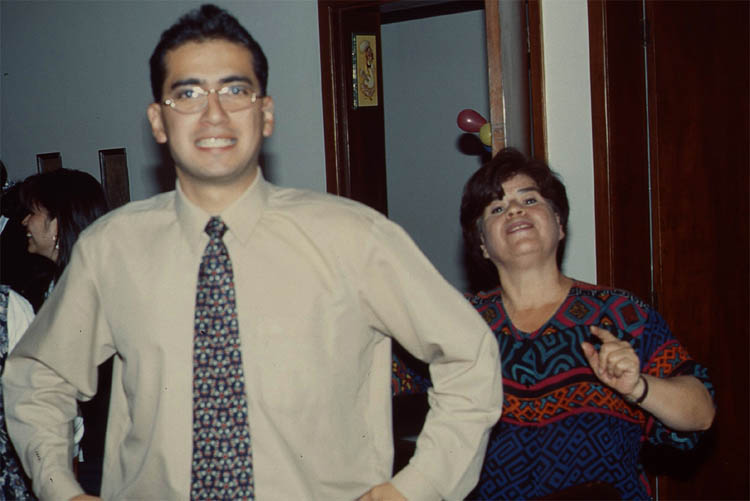
| She is proud of her son, the professional
|

| and the guests are sociedad exepcional
|
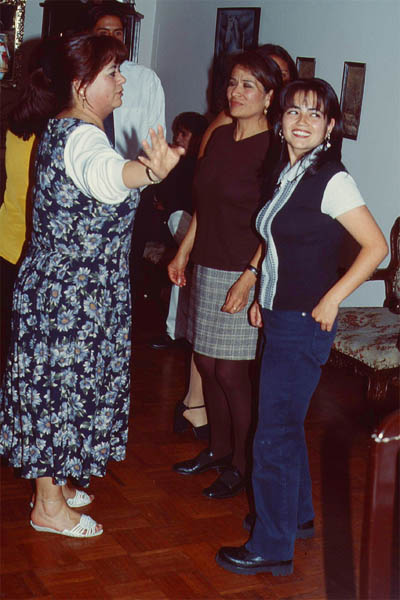
| Feliz signoritas
|
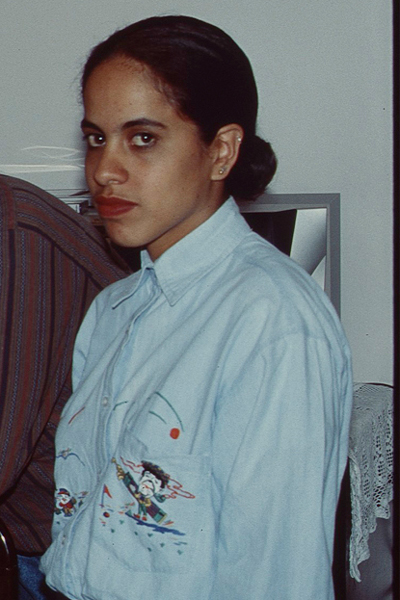
| Serio senorita
|
If you want to skip directly to the next part, then just hit
Part II
| 